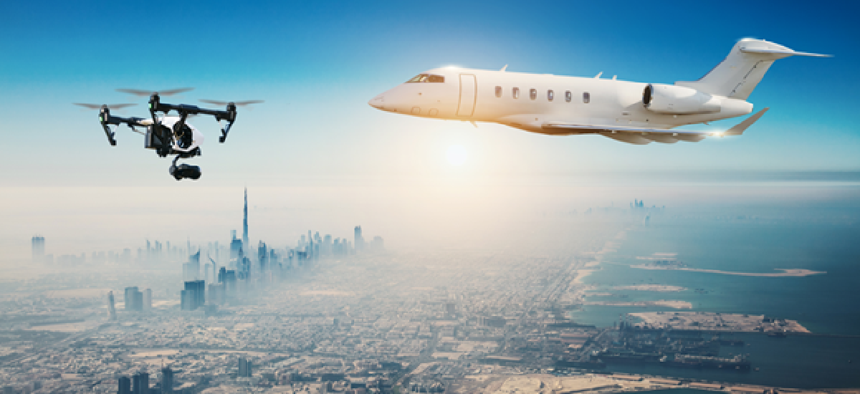FAA pushed to protect airspace from rogue drones

As a new report warns small UAS can do far more damage to planes than bird strikes, legislators worry that "idiots who have toy drones" will delay legitimate UAS uses.
As private and commercial drones take to the skies in increasing numbers, legislators want the Federal Aviation Administration to improve air safety without stalling commercial innovation.
Incidents involving unmanned aerial systems and larger aircraft have become more common. At a Nov. 29 hearing of the House Transportation Committee's Aviation Subcommittee, Chairman Rep. Frank LoBiondo (R-N.J) described a September collision between a U.S. Army helicopter and an illegally operated drone that caused "hundreds of thousands of dollars of damage to that aircraft."
Not long after, an airliner preparing to land in Canada was hit by a drone. "We were lucky," LoBiondo said. "No one was hurt or killed in those incidents. But we cannot count on luck to keep us safe the next time around. "
"The biggest problem so far is with idiots who have toy drones," said Rep. Peter DeFazio (D-Ore.). "This an accident waiting to happen. We are going to lose an aircraft."
At the same time, DeFazio said, "commercial operations should not be held back because we've got these people out there operating these illegally." He expressed disbelief that geofencing -- built-in technology to prevent a UAS from operating near airports or other sensitive efforts -- is not required for all drones sold. And he called for faster deployment of remote detection and identification systems for UAS.
The FAA gets more than 250 sightings a month of potentially risky UAS flights -- often operating too close to airports.
Earl Lawrence, the executive director of the FAA's UAS Integration Office, told legislators "identification is now at the top of our priority." The technology for identifying drones in flight is evolving very quickly, he said, so the agency had taken care to solicit broad industry input. But with that information now gathered, the FAA is now "moving forward with our rule-making activity," he said.
Rep. Bud Shuster (R-Pa.), who chairs the full Transportation and Infrastructure Committee, asked if those rules would be out in within "a few months." Lawrence demurred, saying that "rule-making is a deliberative process."
Shuster said such slowness was a key part of the problem and said that remote identification of UAS was key to both law enforcement and public safety.
Brian Wynne, the president and CEO of the Association for Unmanned Vehicle Systems International, agreed. "We as an organization are against anonymous flying," he said at the hearing. "Aircraft need to be visible to one another so that we can avoid conflicts. … They need to be detecting one another, they need to be identifiable to one another, and they need to be responsible to one another."
The hearing came on the heels of the FAA's announcement of a new report that details the damage small UAS can cause to manned aircraft. That report, produced by the Alliance for System Safety of UAS through Research Excellence (ASSURE), found that drones can cause more structural damage than birds of the same weight for a given impact speed. Manned aircraft are manufactured to withstand bird strikes, but the ASSURE researchers said that small drones pose a much greater risk because of their solid motors, batteries and other parts.
The research team evaluated the potential impacts both quadcopters and fixed-wing drones, ranging from 2.7 to eight pounds, on a commercial jet's windshield,
wing leading edge and vertical and horizontal stabilizers. Damage ranged from non-existent -- the windshield was particularly resilient -- to full penetration of the drone into the airframe.
The team also conducted a preliminary computer simulation to evaluate the potential damage from a UAS ingested into an aircraft engine, but did not conduct physical tests. At the Nov. 29 hearing, DeFazio said those tests are critical. "We need to know what's going to happen when one of these things gets sucked into a turbofan," he said.
FAA Deputy Administrator Daniel Elwell said the agency is working with drone makers to develop technology to detect and avoid planes. And he thanked Congress for reinstating the FAA's authority to require all UAS to be registered, noting that registration is prerequisite for effective identification and in-flight tracking.
The FAA's goal is to "integrate, not segregate" drones in the U.S. airspace, he said, and "remote ID and tracking will be a key component to full integration."
This article was first posted to FCW, a sibling site to GCN.
NEXT STORY: Virginia looks to IT startups for tech infusion





